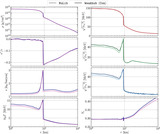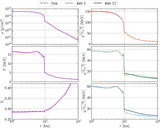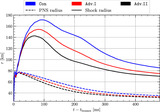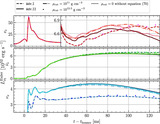Image Details
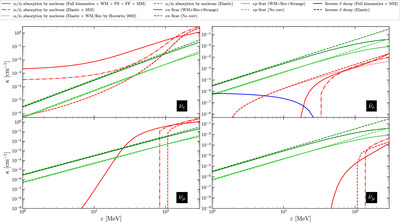
Caption: Figure 4.
Spectra of neutrino opacities for ν l (﹩{\bar{\nu }}_{l}﹩) absorption on neutrons (protons), inverse β decay, and ν N elastic scattering under various approaches, with and without different modifications, at a thermodynamic point in the hot ring region near the core of a BNS postmerger (point (III) in Table 3). The opacities of absorption by nucleons, inverse β decay, and elastic scattering are represented by red, blue, and green, respectively, while various line styles are used to represent the opacities with or without corrections and different treatments of calculations. The abbreviations WM, PS, FF, MM, Elastic, Rec, and Strange correspond to weak magnetism, pseudoscalar, form factor, medium modifications, elastic approximation, approximated recoil, and strange-quark contributions, respectively. The opacities of ν l (﹩{\bar{\nu }}_{l}﹩) absorption by nucleons, calculated using the full kinematics approach and incorporating all available corrections, are 2–3 orders of magnitude higher than those computed using the elastic approximation with approximated corrections from Horowitz (2002). The opacity of inverse β decay is activated due to the medium modifications. The opacity of inverse β decay with elastic approximation and without medium modifications is completely suppressed in the given comparison.
Copyright and Terms & Conditions
© 2024. The Author(s). Published by the American Astronomical Society.





